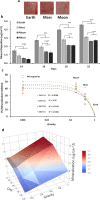Impairment of 7F2 osteoblast function by simulated partial gravity in a Random Positioning Machine
- PMID: 35672327
- PMCID: PMC9174291
- DOI: 10.1038/s41526-022-00202-x
Impairment of 7F2 osteoblast function by simulated partial gravity in a Random Positioning Machine
Abstract
The multifaceted adverse effects of reduced gravity pose a significant challenge to human spaceflight. Previous studies have shown that bone formation by osteoblasts decreases under microgravity conditions, both real and simulated. However, the effects of partial gravity on osteoblasts' function are less well understood. Utilizing the software-driven newer version of the Random Positioning Machine (RPMSW), we simulated levels of partial gravity relevant to future manned space missions: Mars (0.38 G), Moon (0.16 G), and microgravity (Micro, ~10-3 G). Short-term (6 days) culture yielded a dose-dependent reduction in proliferation and the enzymatic activity of alkaline phosphatase (ALP), while long-term studies (21 days) showed a distinct dose-dependent inhibition of mineralization. By contrast, expression levels of key osteogenic genes (Alkaline phosphatase, Runt-related Transcription Factor 2, Sparc/osteonectin) exhibited a threshold behavior: gene expression was significantly inhibited when the cells were exposed to Mars-simulating partial gravity, and this was not reduced further when the cells were cultured under simulated Moon or microgravity conditions. Our data suggest that impairment of cell function with decreasing simulated gravity levels is graded and that the threshold profile observed for reduced gene expression is distinct from the dose dependence observed for cell proliferation, ALP activity, and mineral deposition. Our study is of relevance, given the dearth of research into the effects of Lunar and Martian gravity for forthcoming space exploration.
© 2022. The Author(s).
Conflict of interest statement
The authors declare no competing interests.
Figures




Similar articles
-
Novel, Moon and Mars, partial gravity simulation paradigms and their effects on the balance between cell growth and cell proliferation during early plant development.NPJ Microgravity. 2018 Apr 4;4:9. doi: 10.1038/s41526-018-0041-4. eCollection 2018. NPJ Microgravity. 2018. PMID: 29644337 Free PMC article.
-
Mineralization initiation of MC3T3-E1 preosteoblast is suppressed under simulated microgravity condition.Cell Biol Int. 2015 Apr;39(4):364-72. doi: 10.1002/cbin.10391. Epub 2014 Dec 29. Cell Biol Int. 2015. PMID: 25318973
-
Plant biology in reduced gravity on the Moon and Mars.Plant Biol (Stuttg). 2014 Jan;16 Suppl 1:12-7. doi: 10.1111/plb.12031. Epub 2013 Jul 25. Plant Biol (Stuttg). 2014. PMID: 23889757 Review.
-
Nutraceuticals Synergistically Promote Osteogenesis in Cultured 7F2 Osteoblasts and Mitigate Inhibition of Differentiation and Maturation in Simulated Microgravity.Int J Mol Sci. 2021 Dec 23;23(1):136. doi: 10.3390/ijms23010136. Int J Mol Sci. 2021. PMID: 35008559 Free PMC article.
-
Human Biomechanical and Cardiopulmonary Responses to Partial Gravity - A Systematic Review.Front Physiol. 2017 Aug 15;8:583. doi: 10.3389/fphys.2017.00583. eCollection 2017. Front Physiol. 2017. PMID: 28860998 Free PMC article. Review.
Cited by
-
Microbiology of human spaceflight: microbial responses to mechanical forces that impact health and habitat sustainability.Microbiol Mol Biol Rev. 2024 Sep 26;88(3):e0014423. doi: 10.1128/mmbr.00144-23. Epub 2024 Aug 19. Microbiol Mol Biol Rev. 2024. PMID: 39158275 Review.
-
The Effect of Mixed Polymethylmethacrylate and Hydroxyapatite on Viability of Stem Cell from Human Exfoliated Deciduous Teeth and Osteoblast.Eur J Dent. 2024 Feb;18(1):314-320. doi: 10.1055/s-0043-1768971. Epub 2023 Jun 19. Eur J Dent. 2024. PMID: 37336482 Free PMC article.
-
3D cell culture model: From ground experiment to microgravity study.Front Bioeng Biotechnol. 2023 Mar 24;11:1136583. doi: 10.3389/fbioe.2023.1136583. eCollection 2023. Front Bioeng Biotechnol. 2023. PMID: 37034251 Free PMC article. Review.
-
Omics Investigations of Prostate Cancer Cells Exposed to Simulated Microgravity Conditions.Biomolecules. 2025 Feb 18;15(2):303. doi: 10.3390/biom15020303. Biomolecules. 2025. PMID: 40001606 Free PMC article.
-
Simulated microgravity attenuates myogenesis and contractile function of 3D engineered skeletal muscle tissues.NPJ Microgravity. 2024 Feb 16;10(1):18. doi: 10.1038/s41526-024-00353-z. NPJ Microgravity. 2024. PMID: 38365862 Free PMC article.
References
-
- LeBlanc AD, Spector ER, Evans HJ, Sibonga JD. Skeletal responses to space flight and the bed rest analog: a review. J. Musculoskelet. Neuronal Interact. 2007;7:33–47. - PubMed
-
- Nelson ES, Jules K. The microgravity environment for experiments on the International Space Station. J. Gravit. Physiol. 2004;11:1–10. - PubMed
Grants and funding
LinkOut - more resources
Full Text Sources
Miscellaneous

